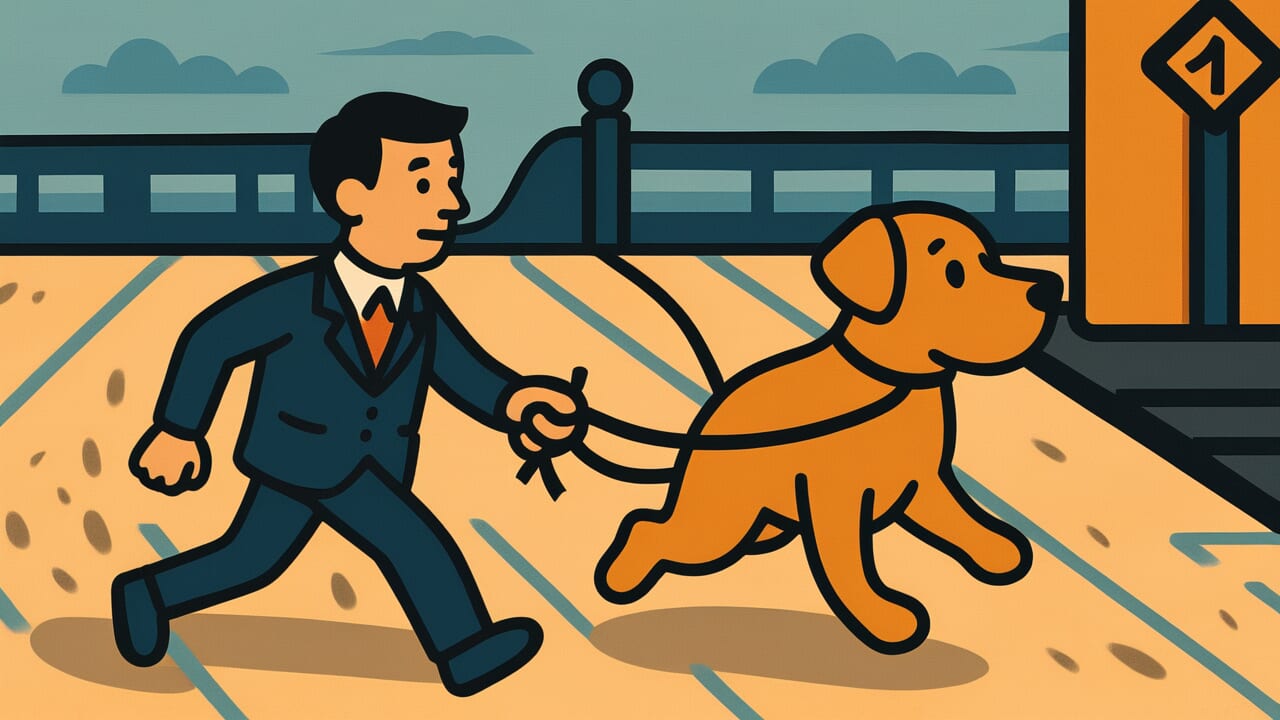How to Read “If you follow a bad person and don’t avoid them, it’s like a tied dog going around a pillar”
Ashiki hito ni shitagatte sakezareba, tsunageru inu no hashira wo meguru ga gotoshi
Meaning of “If you follow a bad person and don’t avoid them, it’s like a tied dog going around a pillar”
This proverb means that if you keep following a bad person, you’ll end up like a tied dog circling a pillar. You move but make no real progress or growth in life.
When you don’t cut ties with someone who has a bad influence on you, you become trapped by their values and behavior patterns. You just repeat the same mistakes and problems over and over.
People use this expression to warn someone stuck in a bad friendship or harmful relationship. Just as a dog loses its freedom when chained, following bad people limits your own will and potential.
Today, we still understand this as a lesson. It tells us to reconsider relationships that prevent our growth or drag us down.
Origin and Etymology
No clear records show the exact origin of this proverb. However, its structure suggests it comes from Buddhist or Confucian moral teachings.
The old-fashioned words like “ashiki hito” (bad person) and “shitagau” (to follow) hint at its age. It likely appeared in moral instruction books from medieval to early modern Japan.
The second half uses a powerful metaphor: “a tied dog going around a pillar.” This describes a scene people saw every day back then.
Tying dogs to posts or stakes was common practice. A tied dog can only move within the length of its chain. It walks in circles around the same spot endlessly.
This image strongly symbolizes lost freedom and a life without progress. It left a deep impression on people’s minds.
The word “shitagau” (to follow) combines with “sakezareba” (if you don’t avoid) to emphasize the meaning. It stresses “if you keep following a bad person and don’t leave them.”
This expression style shows influence from classical Chinese writing. It was passed down as a dignified moral lesson.
Usage Examples
- You won’t learn anything following that senior. If you follow a bad person and don’t avoid them, it’s like a tied dog going around a pillar.
- Staying in that relationship just repeats the same troubles. It’s truly like if you follow a bad person and don’t avoid them, it’s like a tied dog going around a pillar.
Universal Wisdom
Humans have an instinctive desire to feel secure by following someone. But this proverb has been passed down for hundreds of years for a reason.
It shows a harsh truth: if you follow the wrong person, your entire life stagnates.
The tied dog metaphor comes from sharp observation of human nature. The dog appears to be moving, but it’s only circling within the chain’s length. It never moves forward even one step.
This perfectly describes people under bad influence. They seem busy and active, but nothing fundamentally changes. They’re not growing at all.
Why can’t people leave bad influences? Because staying feels easier than finding the courage to cut ties.
Fear of change, anxiety about loneliness, and the belief that “this person is all I have” become chains. But our ancestors saw through this illusion.
They understood a truth: that sense of security is false. Real freedom and growth only come when you bravely distance yourself from bad influences.
This proverb teaches the importance of choices in relationships. Who we walk with determines the direction of our lives.
When AI Hears This
When a dog circles a pillar, its path is mathematically recorded as a “winding number.” Three clockwise circles equal “+3.” Two counterclockwise circles equal “-2.”
The key point: no matter how much the dog moves, this number never changes unless it jumps over the pillar.
In topology, this is called “non-triviality of the fundamental group.” A space with a pillar is “a space with a hole.”
Once a path circles that hole, continuous deformation can never return it to “a path that didn’t circle.” The moment the dog completes one circle, that history is permanently recorded in the space’s structure. It cannot be erased.
Bad relationships have the same structure. Once you enter that relationship, your behavioral history accumulates as a “winding number” with that person.
Debt, shared secrets, complicity—these “windings” never return to zero no matter how slightly you move.
Mathematics teaches that escape requires “changing dimensions.” For the dog, that means cutting the rope. For human relationships, it means physical distance or legal intervention.
You need intervention from outside your current space. No matter how hard you try on the same plane, the winding number—a topological invariant—won’t change. This is the cold truth mathematics reveals.
Lessons for Today
This proverb teaches modern people about “freedom of choice” and “courage to decide” in relationships.
Social media makes connections visible. Breaking relationships has become harder. That’s exactly why this lesson carries more weight today.
Look around you. Some people help you grow and feel positive. Others only complain and throw negative words at you.
Continuing relationships with the latter is like putting chains on your own potential.
What matters is having courage to reconsider relationships. This isn’t coldness. It’s responsibility for your own life.
When you distance yourself from bad influences, space opens up for new encounters and experiences. Just as a tied dog can finally run free when unchained, you can show your true power when released from limitations.
Starting today, why not consciously choose who you share your time and energy with? That choice will greatly change your future.



Comments